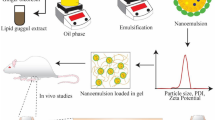Abstract
The Z-ligustilide (LIG) was studied for its anti-inflammatory activities with prepared LIG nanoemulsions (LIGNE). Healthy male adult Wistar rats were used in the study. Endotoxin-induced uveitis (EIU) was induced by a footpad injection of 200 μg lipopolysaccharide. EIU rats were administered orally with saline, LIG (20 mg/kg/day), and LIGNE (20 mg LIG /kg/day), respectively. Twenty-four hours later, rats were euthanized, and blood was collected from either right marginal ear vein to estimate inflammatory cells and inflammatory mediators. The drug dissolution profiles of LIGNE in both phosphate buffer pH 6.8 and 0.1 N HCl showed complete dissolution within 20 min. Pharmacokinetic studies suggested a significant increase (P < 0.0001) in the C pmax and AUC0→24 h were observed in the LIGNE group when compared with the LIG group. LIGNE significantly reduced the levels of tumor necrosis factor alpha, interleukin 1 beta, vascular endothelial growth factor alpha, and interleukin-17. The anti-inflammatory animal testing revealed that LIGNE led to an improvement in oral bioavailability.


Similar content being viewed by others
REFERENCES
Huang, Y.L., J.Y. Sheu, and T.H. Lin. 1999. Association between oxidative stress and changes of trace elements in patients with breast cancer. Clinical Biochemistry 32: 131–136.
Devi, G.S., M.H. Prasad, I. Saraswathi, et al. 2000. Free radicals, antioxidant enzymes and lipid peroxidation in different types of leukemias. Clinica Chimica Acta 293: 53–62.
Butterfield, D.A., B. Howard, S. Yatin, et al. 1999. Elevated oxidative stress in models of normal brain aging and Alzheimer’s disease. Life Sciences 65: 1883–1892.
Steinbrecher, U.P., H. Zhang, and M. Lougheed. 1990. Role of oxidatively modified LDL in atherosclerosis. Free Radical Biol. Med 9: 155–168.
Jira, W., G. Spiteller, and A. Richter. 1997. Increased levels of lipid oxidation products in low density lipoproteins of patients suffering from rheumatoid arthritis. Chemistry and Physics of Lipids 87: 81–89.
Solans, C., P. Izquierdo, J. Nolla, N. Azemar, and M.J. Garcia-Celma. 2005. Nano-emulsions. Current Opinion in Colloid & Interface Science 10: 102–110.
Tadros, T., R. Izquierdo, J. Esquena, and C. Solans. 2004. Formation and stability of nano-emulsions. Advance Opinion in Colloid & Interface Science 108–09: 303–318.
Sonneville-Aubrun, O., J.T. Simonnet, and F. L’Alloret. 2004. Nanoemulsions: a new vehicle for skincare products. Adv Opin Colloid Interface Sci 108–109: 145–149.
Nohynek, G.J., J. Lademann, C. Ribaud, and M.S. Roberts. 2007. Grey goo on the skin? Nanotechnology, cosmetic and sunscreen safety. Critical Reviews in Toxicology 37: 251–277.
Kuang, X., Y. Yao, J.R. Du, Y.X. Liu, C.Y. Wang, and Z.M. Qian. 2006. Neuroprotective role of Z-ligustilide against forebrain ischemic injury in ICR mice. Brain Research 1102: 145–153.
Yu, Y., J.R. Du, C.Y. Wang, and Z.M. Qian. 2008. Protection against hydrogen peroxide-induced injury by Z-ligustilide in PC12 cells. Experimental Brain Research 184(3): 307–312.
Du, J., Y. Yu, Y. Ke, C. Wang, L. Zhu, and Z.M. Qian. 2007. Ligustilide attenuates pain behavior induced by acetic acid or formalin. Journal of Ethnopharmacology 112: 211–214.
Miguel, F., A. Martin, F. Mattea, and M.J. Cocero. 2008. Precipitation of lutein and coprecipitation of lutein and poly-lactic acid with the supercritical antisolvent process. Chemical Engineering and Processing 47: 1594–1602.
Yoo, J.H., S. Shanmugam, P. Thapa, et al. 2010. Novel self-nanoemulsifying drug delivery system for enhanced solubility and dissolution of lutein. Archives of Pharmacal Research 33: 417–426.
Balakrishnan, P., B.J. Lee, D.H. Oh, et al. 2009. Enhanced oral bioavailability of dexibuprofen by a novel solid self-emulsifying drug delivery system (SEDDS). European Journal of Pharmaceutics and Biopharmaceutics 72: 539–545.
Gershanik, T., E. Haltner, C.M. Leh, and S. Benita. 2000. Charge-dependent interaction of self-emulsifying oil formulations with Caco-2 cells monolayers: binding, effects on barrier function and cytotoxicity. International Journal of Pharmaceutics 211: 29–36.
Wei, L.L., P.N. Sun, S.F. Nie, and W.S. Pan. 2005. Preparation and evaluation of SEDDS and SMEDDS containing Carvedilol. Drug Development and Industrial Pharmacy 31: 785–794.
Xi, J., Q. Chang, C.K. Chan, et al. 2009. Formulation development and bioavailability evaluation of a self-nanoemulsified drug delivery system of oleanolic acid. AAPS PharmSciTech 10: 172–182.
Ghosh, P.K., and R.S. Murthy. 2006. Microemulsions: a potential drug delivery system. Current Drug Delivery 3: 167–180.
Liu, Y., P. Zhang, N. Feng, X. Zhang, S. Wu, and J. Zhao. 2009. Optimization and in situ intestinal absorption of self-microemulsifying drug delivery system of oridonin. International Journal of Pharmaceutics 365: 136–142.
Patel, D., and K.K. Sawant. 2009. Self micro-emulsifying drug delivery system: formulation development and biopharmaceutical evaluation of lipophilic drugs. Current Drug Delivery 6: 419–424.
Lu, J.L., J.C. Wang, S. Zhao, et al. 2008. Self-microemulsifying drug delivery system (SMEDDS) improves anticancer effect of oral 9-nitrocamptothecin on human cancer xenografts in nude mice. European Journal of Pharmaceutics and Biopharmaceutics 69: 899–907.
Ghosh, P.K., R.J. Majithiya, M.L. Umrethia, and R.S. Murthy. 2006. Design and development of microemulsion drug delivery system of acyclovir for improvement of oral bioavailability. AAPS PharmSciTech 7: E172–E177.
Calcagni, E., and I. Elenkov. 2006. Stress system activity, innate and T helper cytokines, and susceptibility to immune-related diseases. Annals of the New York Academy of Sciences 1069: 62–76.
Schiller, M., D. Metze, T.A. Luger, S. Grabbe, and M. Gunzer. 2006. Immune response modifiers—mode of action. Experimental Dermatology 15: 331–341.
Annunziato, F., L. Cosmi, F. Liotta, E. Maggi, and S. Romagnani. 2008. The phenotype of human Th17 cells and their precursors, the cytokines that mediate their differentiation and the role of Th17 cells in inflammation. International Immunology 20: 1361–1368.
Stow, J.L., P. Ching Low, C. Offenhäuser, and D. Sangermani. 2009. Cytokine secretion in macrophages and other cells: pathways and mediators. Immunobiology 214: 601–614.
Author information
Authors and Affiliations
Corresponding author
Rights and permissions
About this article
Cite this article
Ma, Z., Bai, L. Anti-inflammatory Effects of Z-Ligustilide Nanoemulsion. Inflammation 36, 294–299 (2013). https://doi.org/10.1007/s10753-012-9546-2
Published:
Issue Date:
DOI: https://doi.org/10.1007/s10753-012-9546-2




